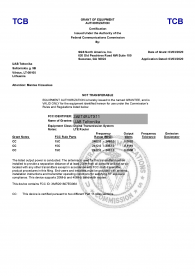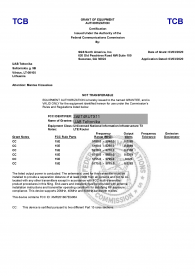RUTX11 FCC: Difference between revisions
No edit summary |
No edit summary |
||
| Line 3: | Line 3: | ||
{{Fcc_Compliance}} | {{Fcc_Compliance}} | ||
==RUTX11 | ==RUTX11 FCC Conformity Procedure== | ||
RUTX11 FCC compliance consists of two main ways of certification at the same time: | |||
# '''For Radio part of the device''': Official Grant of Equipment Authorization Issued Under the Authority of the Federal Communications Commission by testing lab. | |||
# '''For Device itself''': all the necessary testing is done by manufacturer and Supplier's Declaration of Conformity is signed by entity located in United States (importer or distributer). | |||
| Line 17: | Line 20: | ||
{| style="border: 1px solid black; border-spacing: 0; margin: 1em auto;" | {| style="border: 1px solid black; border-spacing: 0; margin: 1em auto;" | ||
|- | |- | ||
! FCC Standard !! Test report No. | !FCC Standard!!Test report No. | ||
|- | |- | ||
| style="text-align: center; width: 250px;" | FCC Code CFR47 Part15C (2019) || | | style="text-align: center; width: 250px;" |FCC Code CFR47 Part15C (2019)|| style="text-align: center; width: 200px;" |SZEM191102057102 SZEM191102057103 | ||
|- | |- | ||
| style="text-align: center; width: 250px;" | FCC Code CFR47 Part15E (2019) || | | style="text-align: center; width: 250px;" |FCC Code CFR47 Part15E (2019)|| style="text-align: center; width: 200px;" |SZEM191102057104 | ||
|} | |} | ||
<br /> | <br /> | ||
== | ==RUTX11 FCC Supplier's Declaration of Conformity== | ||
We, Teltonika, have fulfilled our duty of testing the device for all the required standards by FCC. | We, Teltonika, have fulfilled our duty of testing the device for all the required standards by FCC. | ||
| Line 35: | Line 38: | ||
|} | |} | ||
To download a PDF version of the declaration, <b>[[Media: | To download a PDF version of the declaration, <b>[[Media:FCC SDoC RUTX11.pdf|click here]]</b>. WORD version of the declaration, <b>[[Media:FCC SDoC RUTX11.docx|click here]]</b>. | ||
==RUTX11 FCC== | ==RUTX11 FCC Declaration== | ||
Grantee Code: '''2AET4''' | Grantee Code: '''2AET4''' | ||
Revision as of 08:43, 7 August 2020
Main Page > RUTX Routers > RUTX11 > RUTX11 Certification & Approvals > RUTX11 FCC
The FCC Declaration of Conformity or the FCC label or the FCC mark is a certification mark employed on electronic products manufactured or sold in the United States which certifies that the electromagnetic interference from the device is under limits approved by the Federal Communications Commission.
Description
The FCC label is found even on products sold outside the US territory, because they are either products manufactured in the US and had been exported, or they are also sold in the US. This makes the FCC label recognizable worldwide even to people to whom the name of the agency Federal Communications Commission is not familiar
The Federal Communications Commission established the regulations on electromagnetic interference under Part 15 of the FCC rules in 1975. After several amendments over the years, these regulation were reconstituted as the Declaration of Conformity and Certification procedures in 1998.
FCC Compliance
(15C) This device complies with Part 15 of the FCC Rules. Operation is subject to the following two conditions:
- This device may not cause harmful interference;
- This device must accept any interference received, including interference that may cause undesired operation.
Changes or modifications not expressly approved by the manufacturer could void the user's authority to operate the equipment.
The antenna(s) used for this transmitter must not be co-located or operating in conjunction with any other antenna or transmitter.
(15B) This equipment has been tested and found to comply with the limits for a Class B digital device, pursuant to Part 15 of the FCC Rules.
These limits are designed to provide reasonable protection against harmful interference in a residential installation. This equipment generates, uses and can radiate radio frequency energy and, if not installed and used in accordance with the instructions, may cause harmful interference to radio communications. However, there is no guarantee that interference will not occur in a particular installation. If this equipment does cause harmful interference to radio or television reception, which can be determined by turning the equipment off and on, the user is encouraged to try to correct the interference by one or more of the following measures:
- Reorient or relocate the receiving antenna.
- Increase the separation between the equipment and receiver.
- Connect the equipment into an outlet on a circuit different from that to which the receiver is connected.
- Consult the dealer or an experienced radio/ TV technician for help.
FCC RF Exposure Information
This device complies with the relevant FCC RF radiation exposure limit set forth for an uncontrolled environment.
The antenna(s) used for this transmitter must not be co-located or operating in conjunction with any other antenna or transmitter and must be installed to provide a separation distance of at least 20cm from all persons.
RUTX11 FCC Conformity Procedure
RUTX11 FCC compliance consists of two main ways of certification at the same time:
- For Radio part of the device: Official Grant of Equipment Authorization Issued Under the Authority of the Federal Communications Commission by testing lab.
- For Device itself: all the necessary testing is done by manufacturer and Supplier's Declaration of Conformity is signed by entity located in United States (importer or distributer).
Official Federal Communications Commission for SDoC compliance requires and mandates two major parties:
- manufacturer (Teltonika) to test the device for all applicable standards;
- local US entity (Importer or Marketer) to sign Supplier's Declaration of Conformity.
The RUTX11 conformity with the essential requirements has been demonstrated against the following harmonized standards:
| FCC Standard | Test report No. |
|---|---|
| FCC Code CFR47 Part15C (2019) | SZEM191102057102 SZEM191102057103 |
| FCC Code CFR47 Part15E (2019) | SZEM191102057104 |
RUTX11 FCC Supplier's Declaration of Conformity
We, Teltonika, have fulfilled our duty of testing the device for all the required standards by FCC.
Only Importer or Marketer, local US entity, can sign Supplier's Declaration of Conformity, therefore please find SDoC below and sign by your own entity's name.
 |
To download a PDF version of the declaration, click here. WORD version of the declaration, click here.
RUTX11 FCC Declaration
Grantee Code: 2AET4
FCC ID: 2AET4RUTX11
 |
 |
You can find the PDF versions of RUTX11 FCC grants below:
Disclaimer:
Test reports that are referenced in declarations and certificates can be provided upon request. For the request to be approved, the recipient of the test reports should be a certification authority or certified test house. The recipients will be asked to sign a non-disclosure agreement (NDA).
External links
https://www.fcc.gov/engineering-technology/laboratory-division/general/equipment-authorization
